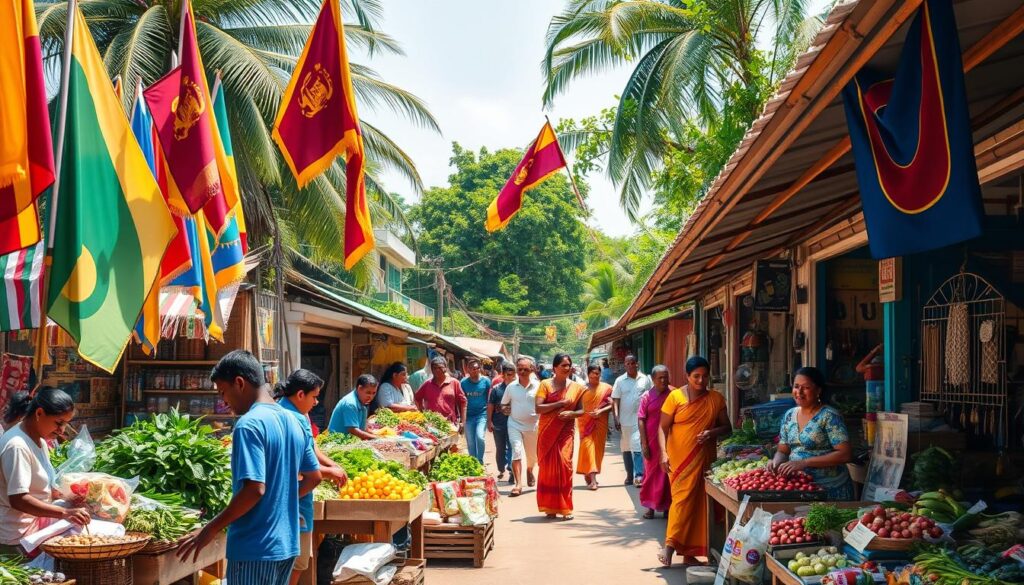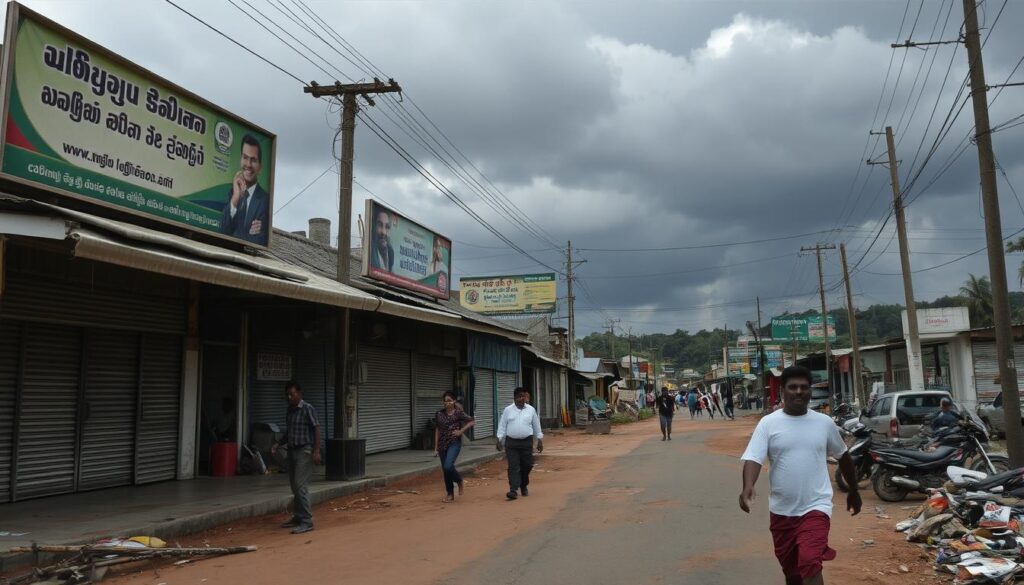Sri Lanka’s Inflation Drops to 2% Amid Economic Reforms
In a big economic shift, Sri Lanka’s Inflation Drops to 2%. This shows great progress towards financial health. Dr. P. Nandalal Weerasinghe, Central Bank of Sri Lanka’s Governor, confirmed this achievement. It’s due to economic reforms started by the nation’s leaders. These measures reached their goal in one year since late 2022. It’s a key time for the Sri Lanka economy.
Now, the Inflation rate is at a controlled 2% inflation. This will help in economic discussions and future policies. It’s aimed at keeping the economic improvement. The Central Bank is keeping a careful watch on policies. OMP Sri Lanka will keep offering true and relevant news.

The Underlying Factors of Sri Lanka’s Deflating Inflation Rate
Sri Lanka’s inflation rate tells a story of monetary policy and market changes. The rate was affected by both demand-pull and cost-push inflation. This was due to local actions and outside situations. The Central Bank played a key role in adjusting the money supply. This helped control both demand-pull and cost-push inflation.
After COVID-19, Sri Lanka, like other countries, faced supply chain issues. These issues pushed inflation higher. This situation made Sri Lanka think deeply about its monetary policy. The goal was to calm the economic storm by keeping an eye on and tweaking the money supply.

A report by OMP Sri Lanka talks about how the Central Bank kept a close watch on the money supply. They worked hard to keep inflation in check. This approach follows Milton Friedman’s idea that inflation is mainly about how much money is out there. It’s a plan backed by both theory and real results, even when times are tough.
Looking at supply chain troubles shows us how deep these problems went. They didn’t just affect shipping. They also made the costs of goods and services go up. This led to higher prices from cost-push inflation. A careful look and smart changes in policy helped Sri Lanka start to lower inflation.
| Year | Inflation Rate | GDP Growth | Monetary Policy Influence |
|---|---|---|---|
| 2022 | 70% | -2.3% | Contractionary |
| 2023 | -0.8% (Deflation) | 4.4% | Stabilization Focus |
The story shows how important smart monetary policy changes are. They help control ups and downs in the economy. This leads to stability in Sri Lanka’s market over the long term.
Examining the Impact of Economic Reforms on Sri Lanka’s Inflation
The link between government reforms and monetary policy is key to Sri Lanka’s economic stability and controlling inflation. Thanks to these efforts, the Central Bank of Sri Lanka Act has driven significant changes. This has led to more stable prices and economic growth.
Government and Monetary Policy Synergy
Strong government reforms and smart monetary policy have greatly reduced inflation in Sri Lanka, bringing it down to 2%. This shows a strong dedication to keeping a tight budget and creating strong fiscal revenue plans. These actions are important for reducing inflation and supporting a stable economy.
The Role of the International Monetary Fund (IMF)
The International Monetary Fund’s Extended Fund Facility (EFF) has played a big part in Sri Lanka’s recovery. It backs major government policies aimed at debt sustainability and better external reserves. These are key for a healthy economy.
Fiscal Reforms and Revenue Collection
Changing how revenue is collected and keeping strict financial control have helped stabilize Sri Lanka’s economy. Better revenue collection methods have helped the country manage its debt. This has led to economic growth and stable prices.
Efforts at both the national and international levels are creating a strategy to improve Sri Lanka’s economy. With ongoing reforms, the nation is building a stronger economic foundation. This sets the stage for a stable and bright future.
Insights from Historical Inflation and Economic Challenges in Sri Lanka
Sri Lanka’s economy tells a story of tough times and bouncing back. This journey shows how deep *economic mismanagement* and ups and downs have led to high inflation rates. Yet, the country has managed to lower its inflation to 2%. This is a big win. Sri Lanka faced many problems like big deficits and payment crises. These issues needed strong *economic planning* and action. Looking back helps avoid big inflation like in Zimbabwe and Germany, making sure spending is under control.
Hyperinflation Episodes and Their Lessons
In Sri Lanka, too much government influence has caused unstable economies before. Learning from these times is crucial for making wise financial rules and *economic planning* . Studying the *structural development challenges* shows how important export and import balance is. Good policies help avoid bad economic situations. Research from 1971 to 2017 shows what works to keep the economy stable.
Structural Reforms and Long-term Economic Planning
Getting over inflation involved major changes and future thinking. After the civil war, the country focused on big *infrastructure projects*. These helped save money, invest wisely, and manage debt better. Financial policies have improved by studying financial trends. This proves that *economic planning* must look ahead, not just react.
The Contribution of Foreign Direct Investment and External Reserves
*Foreign Direct Investment (FDI)* and *gross international reserves* play a big role. Shifting from agency loans to foreign investments made reserve health shaky. But help from India and better reserve management show progress. Even facing a default, the approach is broad. Global economic policies, like those in Joseph Eugene Stiglitz’s report, affect Sri Lanka too. Learn more about how this crisis led to important changes.





